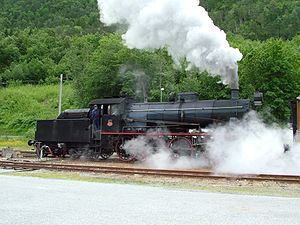NSB type 30
| NSB type 30 | |
|---|---|
|
30a 271 on the room tab
|
|
| Numbering: | 30a 256-258, 271, 272-282, 316-318, 30b 346-368, 30c 466-469 |
| Number: | 45 |
| Manufacturer: |
Thunes mekaniske Verksted : 1914: 30a 256-258, 271 1915: 30a 272-275, 281, 282 1916: 30a 276 1919: 30a 277-280, 316-318 1938: 30c 466, 467 1939: 30c 468, 469 Norsk Maskin Industri : 1920: 30b 346, 347 1921: 30b 348-368 |
| Year of construction (s): | 1914-1916, 1919-1921, 1938, 1939 |
| Retirement: | 1969 |
| Axis formula : | 2'C-2'2 ' |
| Type : | 30a: 2'C-2'2 'h4 30b, 30c: 2'C-2'2' h4v |
| Gauge : | 1435 mm ( standard gauge ) |
| Length over buffers: | 17,642 mm |
| Height: | 4,280 mm |
| Total wheelbase: | 14,822 mm |
| Empty mass: | 30a: 54.7 t 30b: 59.3 t 30c: 60.4 t |
| Friction mass: | 30a: 41.1 t 30b: 42.9 t 30c: 43.9 t |
| Top speed: | 90 km / h |
| Driving wheel diameter: | 1,600 mm |
| Number of cylinders: | 4th |
| HD cylinder diameter: | 30b, 30c: 585 mm |
| LP cylinder diameter: | 390 mm |
| Piston stroke: | 600 mm |
| Boiler overpressure: | 30a: 12 kg / cm 2 30b: 13 kg / cm 2 30c: 16 kg / cm 2 |
| Grate area: | 2.4 m 2 |
| Tubular heating surface: | 125 m 2 |
| Superheater area : | 37 m 2 |
| Service weight of the tender: | 16.6 t 30c: 18.5 t |
| Water supply: | 15 m 3 30c: 18.9 m 3 |
| Fuel supply: | 4 t 30c: 6 t |
The Norwegian steam locomotive series NSB Type 30 was built between 1914 and 1939 by Thunes mekaniske and Norsk Maskin Industri (NMI) for the Norges Statsbaner (NSB), the state railway company in Norway.
history
The NSB 30 was designed as an express locomotive . Their area of operation extended over the whole country. Occasionally it was also used for the transport of freight trains .
NSB type 30a
Between 1914 and 1919 a total of 18 type 30a locomotives of the type 2'C-2'2 'h4 as four-cylinder locomotives were delivered to NSB by Thunes mekaniske .
NSB type 30b
From 1920 the deliveries of the type 30b , now as a four-cylinder compound locomotive of the type 2'C-2'2 'h4v, by Norsk Maskin Industri . This was a cooperation between Thunes mekaniske Verksted and Hamar Jernstøberi , the two largest Norwegian locomotive manufacturers in Norway at the time. The two locomotives delivered at the end of 1920 were followed by 21 between January and August 1921.
NSB type 30c
Almost 20 years later, in 1938 and 1939, another four locomotives of the type 2'C-2'2 'h4v were delivered by Thunes mekaniske Verksted. Compared to the 30b, these had a higher boiler overpressure of 16 kp / cm 2 and an enlarged tender that allowed more supplies to be carried.
Use and whereabouts
After the Second World War , the locomotives were in passenger service on many routes, for example on the Vossebane (until 1949), on the Vestfoldbane (1949–1957), on the Sørlandsbane ( Sira / Egersund - Stavanger until 1956), on the Gjøvikbane (until 1963 ), on the Dovrebane (until 1965), on the Nordlandsbane (until 1957), on the Kragerøbane (1956–1969), on the Valdresbane (1967–1968), on the Randsfjordbane (until 1959), on the Rørosbane (1964– 1969) and on the Raumabane (until 1958). The locomotives were also used to transport freight trains on various occasions.
The last type 30c locomotive , 30c 466 , was retired on October 15, 1969. 30a 271 and 30b 362 were the last active locomotives of the entire series, their service ended on November 9, 1970. 30a 271 has been preserved and is in service with the Norsk Jernbaneklubb (NJK). She pulls museum trains there.
Individual evidence
- ↑ Svein Sando: Tekniske spesifikasjoner for normalsporte damplok NSB. Retrieved December 21, 2013 (Norwegian).
Web links
- Database over rullende jernbanematerialiell brukt i Norge. Norsk Jerbaneklubb, accessed December 21, 2013 (Norwegian).
- Damp lokomotiver Type 30. Jernbane.net, accessed December 26, 2013 (Norwegian).
